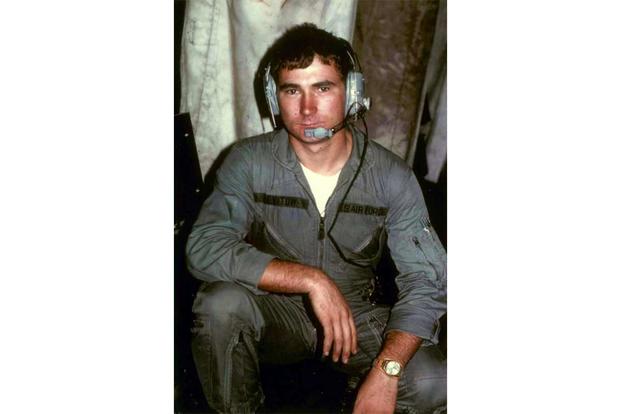This article by David Roza originally appeared on Task & Purpose, a digital news and culture publication dedicated to military and veterans issues.
The annals of the infantry and special forces community are filled with tales of heroes throwing themselves on grenades to save their buddies. Just in the past 20 years, four Medals of Honor were earned by service members who dove onto explosives, knowing full well what the consequences would be.
But 51 years ago Monday, an airman proved that such heroism isn't limited to troops on the ground. Sgt. John Lee Levitow (then an Airman First Class) saved his entire aircrew in the skies above Vietnam by throwing himself on a flare that was mere seconds from igniting into a 4,000 degree fireball that would have melted right through their aircraft.
How did such a strange situation come to be? According to the Congressional Medal of Honor Society, on February 24, 1969, Levitow was a loadmaster aboard an AC-47 gunship flying a night mission in support of Long Binh Army post, in the country's south.
Troops at Long Binh were besieged by enemy mortar fire, wrote Air Force Magazine in a 1984 article. The AC-47, using the call sign Spooky 71, was loaded up with 7.62-mm Miniguns and thousands of rounds of ammunition to help them out.
To guide their aim and provide illumination for troops on the ground, Air Force Magazine explained, the AC-47s used Mark 24 magnesium flares, which were three-foot long metal tubes that weighed 27 pounds a piece.
On a normal day, an airman would trigger the arming mechanism of the flare and chuck it out the plane's cargo door. Ten seconds later, an explosive charge would open the flare's parachute, and 10 seconds after that, the magnesium would ignite, generating a light of 2,000,000 candlepower and a heat of 4,000 degrees Fahrenheit, according to Air Force Magazine.
But February 24, 1969 was not a normal day.
While flying over Long Binh, one of Levitow's crewmates, Airman Ellis Owen, had his finger in the safety pin ring of a flare, getting ready to toss it through the cargo door when an enemy mortar round smashed into Spooky 71, ripping a two-foot hole through the right wing and perforating the fuselage in over 3,500 places, according to Levitow's Medal of Honor citation.
The explosion wounded all five of the crew and slammed them to the floor as Spooky 71 fell into a steep, descending turn to the right, momentarily out of control, Air Force Magazine wrote.
The 23-year-old Levitow, though stunned by the blast concussion and peppered with over 40 fragment wounds in the back and legs, "staggered to his feet and turned to assist the man nearest to him who had been knocked down and was bleeding heavily," the citation read.
Levitow dragged his crewmate away from the opened cargo door, but he noticed that the flare Owen had been holding was now rolling around the aircraft floor amidst thousands of Minigun rounds.
The flare was armed and smoking, and Levitow had no way of knowing how much time was left before it blew. The igniting mechanism could have been damaged too, which might ignite the flare even faster, wrote Air Force Magazine.
"Realizing the danger involved and completely disregarding his own wounds, Sgt. Levitow started toward the burning flare," the award citation read. "The aircraft was partially out of control and the flare was rolling wildly from side to side."
Maybe it was because of the roller coaster airplane, or the loss of blood, or the partial loss of feeling in his right leg, but Levitow just couldn't grab the rolling flare with his hands. Instead, he dove on the burning flare and hugged it to his body as he dragged himself to the cargo door.
With a last burst of strength, the airman hurled the flare, which ignited immediately after leaving the aircraft. As Levitow lapsed into unconsciousness, the pilot regained control of the plane, wrote Air Force Magazine. They landed at Bien Hoa, Spooky 71's home base, and the wounded Levitow was flown to a hospital in Japan.
But that mission wasn't enough for the airman. When he recovered from his wounds, Levitow, who had already flown 181 combat sorties, flew another 20 before returning stateside and completing his enlistment as a C-141 loadmaster at Norton Air Force Base, Calif., according to Air Force Magazine.
On May 14, 1970, just over a year after nearly dying over Long Binh, Levitow was awarded the Medal of Honor at the White House by President Richard Nixon.
"Sgt. Levitow, by his selfless and heroic actions, saved the aircraft and its entire crew from certain death and destruction," read the citation. "Sgt. Levitow's gallantry, his profound concern for his fellowmen, at the risk of his life above and beyond the call of duty are in keeping with the highest traditions of the U.S. Air Force and reflect great credit upon himself and the Armed Forces of his country."
Levitow passed away from cancer in 2000, according to We Are The Mighty. But his legacy burns bright today due to all the awards, buildings and bridges named after him.
So next time you see the airman's name or face anywhere, remember that heroism aims high.
More articles from Task & Purpose:











